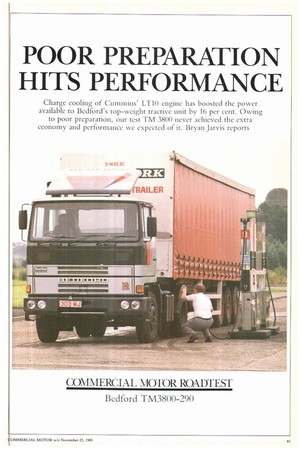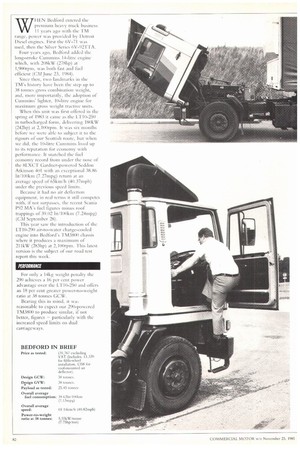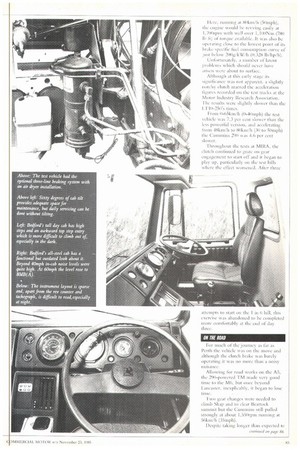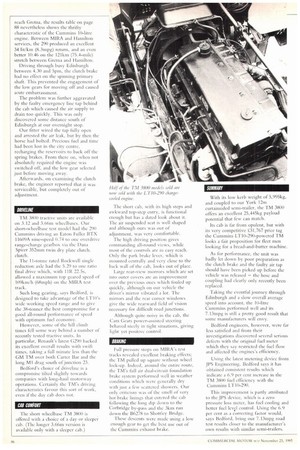POOR PREPARATION HITS PERFORMANCE
Page 83

Page 84

Page 85

Page 88

Page 89

If you've noticed an error in this article please click here to report it so we can fix it.
Charge cooling of Cummins' LT10 engine has boosted the power available to Bedford's top-weight tractive unit by 16 per cent. Owing to poor preparation, our test TM 3800 never achieved the extra economy and performance we expected of it. Bryan Jarvis reports
COMMERCIAL MOTOR ROADITEST Bedford TM3800-290
WI I FIN Bedford entered the premium heavy truck business 11 years ago with the TM range, power was provided by Detroit 1)iesel engines. First the 6V-71 was used, then the Silver Series 6V-92TTA.
Four years ago, Bedford added the long-stroke Cummins 14-litre engine which, with 208k W (278hp) at 1,900rpm, was both fast and fuel efficient (CM June 23, 1984).
Since then, two landmarks iii the TM's history have been the step up to 38 tonnes gross combination weight, and, more importantly, the adoption of Cummins lighter, 10-litre engine for maximum gross weight tractive units.
When this unit was first offered in the spring of 1983 it came Is the LIM-250 in turbocharged form, delivering 180kW (242hp) at 2,100rpm. It was six months before we were able to subject it to the rigours of our Scottish route, but when we did, the 10-litre Cummins lived up to its reputation for economy with performance. It snatched the fuel economy record from under the nose of the 8LXCT Gardner-powered Seddon Atkinson 401 with an exceptional 38.86 liti100km (7.27mpg) return at an average speed of 65km/h (40.37mph) under the previous speed limits.
Because it had no air deflection equipment, in real terms it still competes with, if not surpasses, the recent Scania P92 MA's fuel figures minus roof trappings of 39.02 lit! IC (7.24mpg) (CM September 28).
This year saw the introduction of the LT10-290 air-to-water charge-cooled engine into Bedford's TM3800 chassis where it produces a maximum of 211kW (283hp) at 2,100rpm. This latest version is the subject of our road test report this week. [tete, running at tinknilli (50m ph), the engine would be revving easily at 1,700rpin \vith well over 1,100Nni (781 lb II) of torque available-It was also be operating close to the lowest point of its brake specific fuel consumption curve of just below 200g/kW/h ((1.328 lb/hp/h),
Liii 1ortimately„1 number of latent problems which should never have arisen were about to surface.
Although at this early stage its significance was not apparent, a slightly notchy clutch marred the acceleration figures recorded on the test tracks it the Motor Industry Research Association. The results were slightly slower than the 1.1.10-250's times.
From 0-65ktnih (0-40mph) the test vehicle was 7.3 per cent slower than the less powerful version. and accelerating from 48kmth to 80kin/h (30 to 50mph) the Cummins 290 was 4.6 per cent slower.
Throughout the tests at MIRA, the clutch continued to grate on gear engagement to start off and it began to play up, particularly on the test hills where the effect worsened. After three attempts to start on the I in 6 hill. this exercise was abandoned to be completed more comfortably at the end of day dirce.
reach Gretna, the results table on page 88 nevertheless shows the thrifty characteristic of the Cummins 10-litre engine. Between MIRA and Hamilton services, the 290 produced an excellent 34 lit/km (8.3nipg) return, and an even better 10.46 on the 12Ikm (75.4-mile) stretch between Gretna and Hamilton.
Driving through busy Edinburgh between 4.30 and Spin, the clutch brake had no effect on the spinning primary shaft. This prevented the engagement of the low gears for moving off and caused acute embarrassment.
The problem was further aggravated by the faulty emergency line tap behind the cab which caused the air supply to drain too quickly. This was only discovered some distance south of Edinburgh at our overnight stop.
Our fitter wired the tap fully open and arrested the air leak, but by then the horse had bolted. Precious fuel and time had been lost in the city centre, recharging the reservoirs to back off the spring brakes. From there on, when not absolutely required the engine was switched off, and the low gear selected just before moving away.
Afterwards, on examining the clutch brake, the engineer reported that it was serviceable, but completely out of adjustment.
DRIVE-11H TM 3800 tractive units are available on 3.12 and 3.66m wheelbases. Our short-wheelbase test model had the 290 Cummins driving an Eaton Fuller RTX 11609A nine-speed 034 to one overdrive range-change gearbox via the Dana Spicer 352mni twin dry plate clutch. clutch.
The I 1-tonne rated Rockwell single reduction axle had the 5.29 to one ratio final drive which, with I 1R 22.5s, allowed a maximum top geared speed of 109km/h (68mph) on the MIRA test track.
Such long gearing, says Bedford, is designed to take advantage of the LTIo's wide working speed range and to give the 38-tonner the best compromise for a good all-round performance of speed with optimum fuel economy.
However, some of the hill climb times fell some way behind a number of recently tested tractive units. In particular, Renault's latest G290 backed its excellent overall results with swift times, taking a full minute less than the GM TM over both Carter Bar and the long M1 drag south of junction 23.
Bedford's choice of driveline is a compromise tilted slightly towards companies with long-haul motorway operations. Certainly the TM's driving characteristics favour this sort of work, even if the day cab does not.
CAS COMFORT The short wheelbase TM 3800 is offered with a choice of a day or sleeper cab. (The longer 3.66in version is available only with a sleeper cab.)
The short cab, with its high steps and awkward top-step entry, is functional enough but has a dated look about it. The air suspended seat is well shaped and although ours was out of adjustment, was very comfortable.
The high driving position gives commanding all-round views, while most of the controls are in easy reach. Only the park brake lever, which is mounted centrally and very close to the hack wall of the cab, looks out of place.
Large rear-view morrors which are set into outer covers are an improvement over the previous ones which fouled up quickly, although on our vehicle the driver's mirror vibrated a lot. The mirrors and the rear corner windows give the wide rearward field of vision necessary for difficult road junctions.
Although quite noisy in the cab, the Cam Gears power-assisted steering behaved nicely in tight situations, giving light yet positive control.
8114KINC Full pressure stops on MI RA's test tracks revealed excellent braking effects; the TM pulled up square without wheel lock-up. Indeed, around the entire route, the TM's full air dual-circuit foundation brake system performed well in weather conditions which were generally dry with just a few scattered showers. Our only criticism was of the smell of very hot brake linings that entered the cab following the long dip down to the Corbridge by-pass and the 3kin run down the B6278 to Shottley Bridge.
These descents were made using a low enough gear to get the best use out or the Cummins exhaust brake.
SUMMARY
With its low kerb weight of 5,995kg, and coupled to our York 12m curtainsided semi-trailer, the TM 3800 offers an excellent 25,445kg payload potential that few can match.
Its cab is far from opulent, but with its very competitive S:31,767 price tag the Cummins LT10-290-powered TM looks a fair proposition for fleet men looking for a bread-and-butter machine.
As for performance, the unit was badly let down by poor preparation as the clutch brake and the faulty air tap should have been picked up before the vehicle was released — the hose and coupling had clearly only recently been replaced.
Taking the eventful journey through Edinburgh and a slow overall average speed into account, the 10-litre Cummins performed well and its 7.13mpg is still a pretty good result that some manufacturers will envy.
Bedford engineers, however, were far less satisfied and from their investigations discovered several serious defects with the original fuel meter which they say restricted the fuel flow and affected the engines's efficiency.
Using the latest metering device from JPS Engineering, Bedford says it has obtained consistent results which indicate it 6.9 per cent increase in the TM 3800 fuel efficiency with the Cummins LT10-290.
This improvement is partly attributed to the 'PS device, which is a zero pressure loss meter, has fuel cooling and better fuel levil control. Using the 6.9 per cent as a correcting factor would, says Bedford, bring our 7.13mpg road test results closer to the manufacturer's own results with similar semi-trailers.
TERMS OF WARRANTY
Vehicle: 12 months' unlimited mileage on parts .ind labour. For an extra charge, Commercial cover gives a further 12 months' driveline warranty. Bedford's Supreme cover IS also available for the second and/or third year with an option to renew for a fourth year. This also covers specific driveline components, towing charges and the cost of a replacement vehicle.
Bedford also provides a itiaiuitenatice agreement on purchase that determines servicing costs in advance for the vehicle's life. It carries an indemnity against excessive charges incurred.
Engine: Cummins 'warranty 00 LT11) engines is a on a sliding scale extending to three years (300010 miles). For one year cloi),(0,1 miles) parts and labour are covered. The second and third year (10000 to 300,0011 miles) warranty only applies to block, crankcshaft and rods .ind excludes labour.
Cummins also offers a live-year or one million km (622,000 miles) Custom Cover warranty on "listed parts onlytbr a one-off f. Wu payment.












































































































































